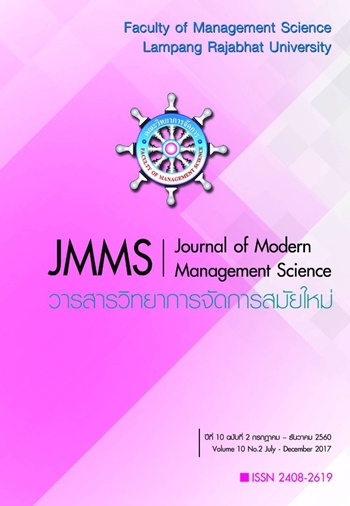รูปแบบการบริหารงานคุณภาพของมหาวิทยาลัยเอกชนไทย โดยการใช้กระบวนการบริหารทรัพยากรมนุษย์
Main Article Content
Abstract
The purposes of this research were to 1) study the quality management of private universities in Thailand, which consists of Leadership, Strategic Planning, Stakeholder, Market Focus, Measurement, Analysis and Knowledge Management, Workforce Focus, and Process Management; 2) explore Human Resource Management Process which includes business capabilities, strategic capabilities, and HR professional capabilities; 3) examine the relationship between quality management and human resource management processes; 4) seek for a model for private university in Thailand to achieve total quality management by human resource management.
The sample consisted of 346 senior executives. The statistics used to analyze data and the criteria used to discuss the results; specifically, general data analysis used for descriptive statistics were frequency and percentage. Besides, analysis of dependent variables, quality Management of Thai Private Universities used descriptive statistics to determine frequency, percentage, means, and standard deviation. Analysis of independent variables, human resource management used descriptive statistics that were frequency, percentage, mean, and standard deviation. Test the hypothesis of relationship between quality management model and human resource management used canonical correlation analysis. The research found the results as listed below;
1.The quality management model of private universities in Thailand that has the highest means is workforce focus that the performance is at high level with an average of 4.45.
2.Human Resource Management Process that has highest average is business capabilities and strategic capabilities with the performance at high level of 4.38.
3.The results of the relationship between quality management and human resource management process indicated that business capabilities toward the modification of enterprises have the relationship with the quality management model in term of strategic planning and managing strategic capabilities in determination of the strategies. For a HR model with the framework of the capabilities, there is the relationship with the quality model in term of strategic planning and the HR Professional capabilities. For in the wide range of wage structure has the relationship with the quality management model in customers and market focus, measurement, analysis and knowledge management, and workforce focus.
4.Summary of the quality management model of private universities will have business capabilities, strategic capabilities, and HR proficiency in order to achieve as well. Human Resource Management is in the field of business organization, HR Modeling with a competency framework wide wage structure.
Article Details
The article must be considered and accepted for publication by the editorial board of the Faculty of Management Science, Lampang Rajabhat University. The articles have been reviewed by a peer (peer review) and the author must update according to the suggestion if available before publication. Articles that are not considered the editorial team will inform the results of the consideration but will not send the original to the author.
JMMS is the Faculty of Management Science journal, Lampang Rajabhat University. Jmms published both print and online editions. We allow the use of articles for academic use under the scope of copyright law.
References
ธนภณ ภู่มาลา. (2552). การบริหารจัดการมหาวิทยาลัยที่ดีในประเทศไทย. ดุษฎีนิพนธ์ปรัชญาดุษฎีบัณฑิต สาขารัฐประศาสนศาสตร์, วิทยาลัยบริหารรัฐกิจ มหาวิทยาลัยบูรพา.
Agere, S. (2000). Promoling Good Governance : Pratices and Perspective. London : Commonwealth Secretariat.
Asian Development Bank (ADB). (1999). Governance in Thailand : Challenge, Issues and Prospects. Report.
Arthur Anderson & American Productivity & Quality Center.(1996). The Knowledge Management Assessment Tool: External Benchmarking Version, Arthur Anderson/APQC, USA.
Certo, S. C. (1997). Modern Management. New Jersey : Prentice-Hall.
Chevalier, J. (2001). Stakeholder Analysis and Natural Resourse Management, http://www.carleton.caJche-Vali.STAXH2.html
Clarke, T. & Stewart C. (1998). Changing Paradigms : Transformation of Management Knowledge for the 21st century London, Harper Collins
Daft, R. L. (2002). Management. (6th ed.). Mason, OH: South-Western.
Denhardt, J. V. & Robert B. D. (2003). The New Public Service : Serving, not Steer. New York : M.E. Sharpe, Inc .
Dering, N. (1998). Leadership in quality organizations. The Jounal for Quality and Participation, 21(1), 32-35. Retrieved from Proquest database.
Dixon, N. (1994). The Organization Learning Cycle. Mc. Graw Hill.
Fiedler, F. E. & Grecia, J. E. (1987). New approaches to Leadership. Cog native resources and organizational performance. New York : John Wiley.
Gartner, Tanya, Hans O. & Dirk R. (2002). A Guided Tour through knowledgemotion (tm) : The Siemens Business Services Knowledge Management Framework, in Knowledge Management Case Book : Siemens Best Practices, Editors – Thomas H. Davenport & Gilbert J. B. Probst, Publicis Corporate Publishing and John Wiley & Sons, Germany,
162-176.
Grimble, R. & Wellard K. (1997). Stakeholder analysis for natural resource management in developing countries : Some practial guidelines for making management more participatory and effective, Agricultural Systems Journal 55(2).
Holsapple, C. W. & Joshi K.D.. (2002). Understanding Knowledge Management Solutions : The Evolution of Frameworks in Theory and Practice in Knowledge Management Systems: Theory and Practice, Stuart Barnes (Editor), Thompson Learning, The Alden Press, UK, 222-241.
Hilliard G. V. & Norman D. K. (1999). Department of Public Management and Business Management. Port Elizabeth Technikon.
House, R. J. (1996). Path-goal theory of Leadership : Lesson, Legacy, and Reformulated theory. Leadership Quarterly, 7, 323-352.
Malcom Baldrige National Quality Award. (2010) .Education Criteria For Performance Excellence.
Taro Yammane. (1973). Statistics : An introductory Analysis. Tokyo : Harper International Edition.
Thailand Quality Award. (2007). Criteria for Performance Excellence.


